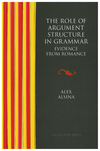This volume articulates a theory of syntax in which argument structure is the level of representation that underlies the alternative syntactic frames of a predicate such as we find in active/passive alternations. It argues for treating argument structure as distinct, in both form and substance, from other levels of representation, particularly those that represent grammatical functions and surface constituency, and related to them by correspondence principles. The evidence for this theory includes the analysis of reflexivized constructions, case marking, and causative constructions in Romance, with special focus on Catalan. These analyses raise important problems for commonly accepted assumptions in theoretical frameworks such as GB; for example, for the hypothesis that predicates have a uniform phrase structure representation of their arguments. It is argued that predicates have a uniform representation of their arguments at argument structure, which map onto possibly alternative overt expressions through the mediation of grammatical functions.
Alex Alsina teaches in the Faculty of Translation and Interpretation of the Universitat Pompeu Fabra of Barcelona.
- Acknowledgements
- Cross-Referencing and Abbreviations
- 1 Introduction
- 1.1 Some Puzzles
- 1.2 Argument Structure
- 1.3 The Emergence of Argument Structure
- 1.4 The Autonomy of A-Structure
- 1.5 Contents
- 2 The Theoretical Framework
- 2.1 C-Structure and F-Structure
- 2.1.1 Internal Organization
- 2.1.2 Pairing of C-Structures and F-Structures
- 2.1.3 Assignment of Grammatical Functions
- 2.1.4 An Example of Function-Category Mapping
- 2.2 A-Structure
- 2.2.1 The Prominence Ranking of Arguments
- 2.2.2 The Proto-Role Classification
- 2.2.3 Mapping to Grammatical Functions
- 2.3 Active/Passive Alternation
- 2.3.1 The Active Structure
- 2.3.2 Passive
- 2.3.3 The Passive Oblique
- 2.3.4 Obliques
- 2.4 Nonargument Functions
- 2.4.1 Discourse Functions
- 2.4.2 Raising Functions
- 2.4.3 Expletive Functions
- 2.5 Summary
- 3 The Romance Reflexive Clitic
- 3.1 Two Current Approaches
- 3.2 Valence Reduction
- 3.2.1 NP Extaposition
- 3.2.2 Case Marking in Causative Constructions
- 3.2.3 Nominalizations
- 3.2.4 Past Participle Agreement
- 3.2.5 Conclusion
- 3.3 Reflexized Verbs are Unaccusatives
- 3.3.1 Auxiliary Selection
- 3.3.2 Causatives of Reflexivized Verbs
- 3.3.3 Participial Constructions in Italian
- 3.3.4 Summary
- 3.4 Reflexized Verbs are not Unaccusatives
- 3.4.1 Bare Plural/Mass NP
- 3.4.2 En-Clitization
- 3.4.3 Modifiers of the Logical Subject
- 3.4.4 Subject Selection with Ditransitives
- 3.5 The Paradox
- 4 Solving the Paradox
- 4.1 A-Structure Binding
- 4.2 Explaining the Facts
- 4.2.1 Valence Reduction
- 4.2.2 The Unaccusative Behavior
- 4.2.3 The Unergative/Transitive Behavior
- 4.2.4 Conclusion
- 4.3 Is Reference tto the External Argument Needed?
- 4.3.1 Passives
- 4.3.2 Raising Verbs
- 4.3.3 Unnaccusative Verbs
- 4.3.4 Summary
- 4.4 Comparison with Other Theories
- 5 Objects and Case Marking
- 5.1 Indirect Objects are Direct Functions
- 5.2 Morphological Case
- 5.2.1 Dative: The Marked Case Value
- 5.2.2 Overt Realization Case
- 5.2.3 The Dative Object as a PP
- 5.3 Case Assignment
- 5.3.1 Two Competing Generalizations
- 5.3.2 Case Assignment Convention
- 5.3.3 Case abd Reflexivized Predicates
- 5.3.4 No Dative Subjects in Romance
- 5.4 Implications
- 6 Causatives
- 6.1 The A-Structure and the F-Structure
- 6.1.1 A Complex Predicate
- 6.1.2 Morphological Predicate
- 6.1.3 Object/Oblique Alternation
- 6.1.4 Summary
- 6.2 The C-Structure of Causatives
- 6.2.1 A Functionally Double-Headed C-Structure
- 6.2.2 Word Order in Causative Constructions
- 6.3 The Causee is not a Grammatical Subject
- 6.3.1 Absence of Subjecthood Properties
- 6.3.2 The Causee and Floating QUantifiers
- 6.3.3 The Causee and Quantifier Binding
- 6.3.4 Reflexized Causatives
- 6.3.5 Summary
- 6.4 The Causee is a Logical Subject
- 6.4.1 A Logical Subject Reflexive
- 6.4.2 Control into Adverbial Clauses
- 6.4.3 Conclusion
- 6.5 Conclusions
- 7 Two Types of Binding
- 7.1 Syntactic Anaphors
- 7.2 The Reflexive Clitic as Clitic Double
- 7.3 Further Consequences
- 7.4 Reciprocal Readings with “Inversion” Verbs
- 7.5 Discussion
- 8 Conclusions
- 8.1 The CURT, the PEAR, and the 1-1 Match
- 8.2 For an Autonomous Argument Structure
- 8.3 Autonomous Levels of Representation
- Bibliography
- Index
4/1/96


